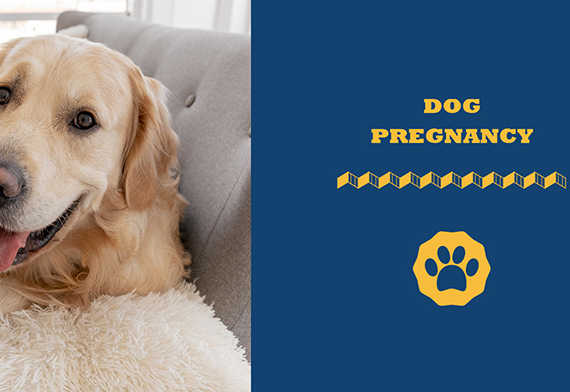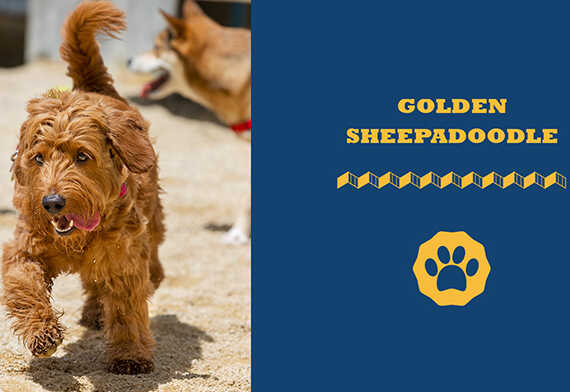Updated: October 13th, 2022
This article contains affiliate links. Read the full disclosure here.
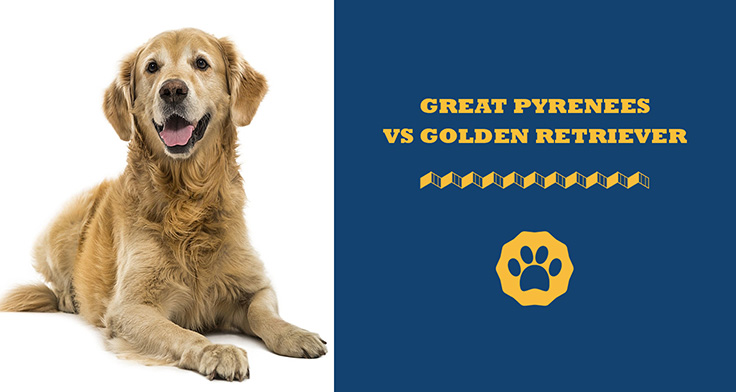
The Great Pyrenees and golden retriever have a lot in common, but they are also two very different dog breeds. Knowing the differences between the Great Pyrenees vs golden retriever is key if you are trying to decide which of these breeds will make a better pet for your family.
While both are unbelievably cute and fluffy, the Great Pyrenees is a powerfully built working dog that can be a loving companion and a vigilant guard dog that will protect your home and family. The golden retriever, on the other hand, is a medium to large size gun dog, and one of the most popular breeds thanks to its eager-to-please, playful, and friendly nature.
If you are having trouble deciding whether the Great Pyrenees or golden retriever is a better choice for your family, I’m here to help! Keep on reading to see how these two breeds compare to one another and which is the perfect match for you.
Great Pyrenees vs Golden Retriever Size, Height & Weight
Size is the first of many differences between the Great Pyrenees and the golden retriever.
The Great Pyrenees is a strong, large breed that stands between 25 and 32 inches tall at the shoulder and weighs from 85 to 160 pounds. Male dogs tend to be noticeably bigger than females.
By comparison, a golden retriever breed standard calls for an athletically built, medium to large dog. Golden retrievers weigh between 20 and 24 inches tall at the withers and weigh from 55 to 75 pounds.
While both breeds are on the larger side, the Great Pyrenees is significantly bigger and can weigh twice as much as a full-grown golden retriever.
Golden Retriever vs Great Pyrenees Coat And Color
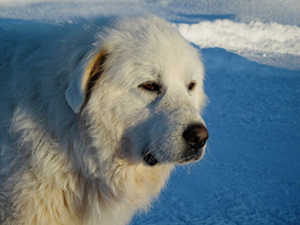
Both goldens and the Great Pyrenees have double coats and are moderate to heavy shedders depending on the time of year. Getting either one of these two breeds might not be the best idea if cleaning dog hair isn’t your cup of tea.
The Great Pyrenees has a double coat that consists of a thick and coarse topcoat and a dense and woolly undercoat. Depending on the climate they live in, Great Pyrs are considered moderate to heavy shedders.
Although generally white, Great Pyrenees can also have badger, tan, grey, or reddish-brown markings. They can sport markings on the head, as a mask, on the ears, on the tail, and sometimes they can also have markings on the body.
Golden retrievers also have dense double coats and thick undercoats, but the main difference is that they have a water-repellent outer coat. A golden will shed moderately during spring and winter and heavily in the spring and fall.
When it comes to coat color, different types of golden retrievers come in various shades of gold, from light to dark golden. The coat can be wavy or straight, and goldens have heavy feathering on the chest, tail, and back of the thighs.
Great Pyrenees Compared To Golden Retriever Temperament
Although both breeds make excellent pets and companions, the Great Pyrenees and the golden retriever have completely different temperaments.
If you are looking for an affectionate, confident, and gentle canine companion that can double as a guard dog, the Great Pyr might be a better choice. But, if you are searching for a playful, trusting, intelligent, and highly trainable family dog, the golden retriever is the right breed for you.
Known for being independent and smart, Great Pyrenees are typically gentle, calm, and loving dogs that like spending time with their owners and shower them with affection. Given their livestock guarding history, Great Pyrenees also make excellent guardians and protectors of your family and home.
Unlike the highly trainable goldens, though, the Great Pyr has a stubborn streak and can be difficult to train. They need an experienced owner and consistent training from a young age in order to grow into obedient and well-mannered dogs.
Golden retrievers, on the other hand, are often described as kind, playful, and loving dogs that make great companions to people of all ages and families with children. As a member of the sporting dog group, the golden is an athletic and energetic dog that loves to play and needs a lot of exercise.
Highly intelligent and eager to please, golden retrievers are easy to train and can learn tricks and obedience in no time. This makes them suitable for both experienced and novice owners who know nothing about golden retriever obedience training.
Both golden retrievers and the Great Pyrenees make wonderful pets and companions when properly trained and socialized from an early age. However, a Great Pyrenees might be a better choice if you are looking for an affectionate, calm, gentle companion that can double as a guard dog. Due to their large size and stubborn nature, the Great Pyrenees isn’t a good choice if you are a novice owner.
A golden retriever might be a perfect breed if you are looking for a friendly, kind, playful, and highly trainable family companion. Goldens get along with everyone but are best suited for active people, families with children, and homes with access to outdoor space.
Golden Retriever vs Great Pyrenees Health
The good news is that both Great Pyrenees and golden retrievers are generally healthy breeds. In fact, both goldens and Great Pyrs have an average life expectancy of 10 to 12 years.
Like all other dog breeds, however, the golden retriever and the Great Pyrenees are prone to certain health conditions. This doesn’t mean that your dog will have any of these issues! However, this is something you should keep in mind when deciding whether to get the Great Pyrenees or a golden retriever.
The most common health problems are:
- Hip dysplasia
- Elbow dysplasia
- Cataracts
- Gastric torsion
- Addison’s disease
- Von Willebrand’s disease
To keep your pup happy and healthy, you’ll need to take them to regular veterinary checkups and keep up to date with their shots. This way, your vet can catch any breed-related health issues early on and treat them before they get out of hand and become serious.
Great Pyrenees And Golden Retriever Grooming Needs
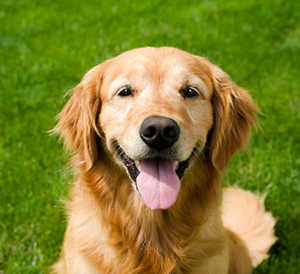
As mentioned, both golden retrievers and the Great Pyrenees have dense double coats. They also shed moderately all year round, and go through a heavy shed during spring and fall. Whichever of these breeds you decide to bring home, you’ll need to adapt to seeing a certain amount of dog hair on your furniture and clothes.
Grooming a Great Pyrenees is easier than it looks and will only take 30 minutes of your time each week. Although they are white, Great Pyrenees have a dirt shedding coat and don’t need frequent baths.
On the other hand, the golden’s thick, water-repellent coat requires a lot of grooming to stay clean and tangle-free. Ideally, you should brush your golden retriever daily, to minimize the shedding and prevent mats from forming. Furthermore, goldens also need regular baths, and you’ll have to bathe your pooch once a month to keep their coat clean and smelling nice.
FAQs About Great Pyrenees Compared To Golden Retriever
What dog is similar to the Great Pyrenees?
Maremma sheepdog is very similar to the Great Pyrenees dog breed and is also bred for the purpose of guarding livestock. This breed is rumored to bark less than the Great Pyrenees and is also better suited for smaller, unfenced farms. Originally from Italy, the Maremma sheepdog is smaller than the Great Pyrenees and is between 23.5 to 28.5 inches tall, weighing between 65 and 100 pounds.
What dog is like a golden retriever but smaller?
The Nova Scotia duck tolling retriever is a medium-sized gun dog bred for hunting. They are the smallest of all retriever breeds and are often mistaken for small golden retrievers. Eager to please, intelligent, active, and friendly, the Nova Scotia duck tolling retriever is a versatile breed that excels at agility and obedience, and makes a great family companion.
Are Great Pyrenees dangerous?
The Great Pyrenees isn’t inherently a dangerous dog breed; however, they are large and have a stubborn streak. This, combined with a lack of training and socialization from a young age, can make the Great Pyrenees potentially dangerous. But, with proper training and socialization, this breed is no more dangerous than any other dog breed and makes a wonderful guardian and family companion.
Conclusion
The Great Pyrenees is a large dog breed that is best suited for experienced owners and makes a wonderful companion when trained and socialized early on. Eager to please, playful, trusting, and friendly golden retrievers are easy to train and are best suited for active people and families with children. With that being said, the biggest differences between the Great Pyrenees vs golden retriever are:
- Golden retrievers are easy to train, while the Great Pyrenees are stubborn
- The Great Pyrenees is moderately active, while goldens need a lot of exercise
- The golden retriever is smaller than a Great Pyrenees dog
At A Glance: Best Products For A Golden Retriever
- KONG Classic Dog Toy – Best Chew Toy For Goldens
- Halti Nylon Training Dog Lead – Best Training Dog Lead
- Zuke’s Mini Naturals Training Dog Treats – Best Training For Golden Retrievers
- FURminator DeShedding Ultra Premium Shampoo For Dogs – Best Dog Shampoo For Shedding

